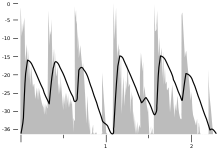Override reserve
Overdrive reserve is a term used in analog sound technology and describes a dynamic range of the transmission channel that usually remains unused. It is not synonymous with the term headroom .
In event technology in particular, the level fluctuations can be so great that the incoming signal can unexpectedly be considerably louder than the previously determined nominal level. The input of the channel must therefore still be able to transmit such levels without distortion.
Signals already recorded on a sound carrier do not, in principle, require any overdrive reserve . However, if the recorded signal is routed through a channel strip of an analog mixer, for example, raising individual frequency bands within a tone control (bass, middle, treble) can lead to a level that is too high. In this case, an overdrive reserve is required within the mixer .
The maximum level of analog mixers and other professional analog devices is usually +22 dBu . This is the level that can be achieved, for example, with OpAmps and supply voltages of +18 V and −18 V. The headroom of such analog devices is, if you take the European studio level of +6 dBu as a starting point, about 16 dB. The professional audio technology, predominantly dominated by American and Japanese companies, has its reference level usually at +4 dBu, so there is 18 dB headroom . This overdrive reserve enables comfortable and risk-free work with manual setting of the channel level.
criticism

The terms overdrive reserve and headroom are not clearly delimited in the current literature and especially in articles on the Internet; in some cases they are even used synonymously.
The representation that the difference between +4 dBu and +22 dBu is to be viewed entirely as an overdrive reserve is also questionable. It can only be regarded as approximately justified in connection with less inert measuring instruments, for example the QPPM . When using an American VU meter with, for example, 300 ms integration time, a particularly large headroom must be provided, since even slightly dynamic signals are higher in peak level than the VU display of the same signal.
It may be necessary - as measured by VU meter - for highly dynamic signals of the entire range +4 dBu to +22 dBu headroom = headroom are considered. An exact observation is not possible, however, because "the" VU meter does not exist in the form of a clear standardization, as operated by ARD or EBU. The standards ANSI C16.5-1942, British Standards BS 6840, and IEC 60268-17 may not be clear enough here.
literature
- Michael Dickreiter, Volker Dittel, Wolfgang Hoeg, Martin Wöhr (eds.): Manual of the recording studio technology . 8th, revised and expanded edition, 2 volumes, Verlag Walter de Gruyter, Berlin / Boston 2014, ISBN 978-3-11-028978-7 or e- ISBN 978-3-11-031650-6 .
Individual evidence
- ↑ Audio technology - Higher Federal Graphical Training and Research Institute, Vienna XIV